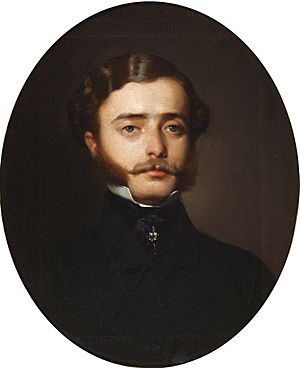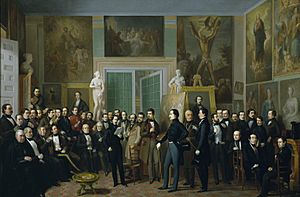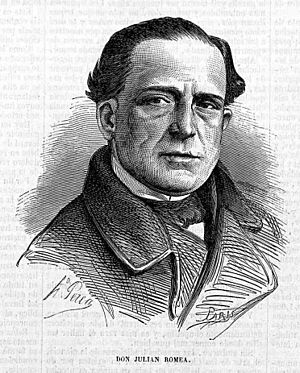Julián Romea facts for kids
Julián Romea Yanguas (born February 16, 1813, in Murcia; died August 10, 1868, in Loeches) was a famous Spanish theater actor and writer. He was the head of an important family of actors, which included his nephew Julián Romea Parra and his son Alberto Romea Catalina.
Contents
Early Life and Career
Julián Romea was born in Murcia, Spain. He was the second of six children. His father, Mariano Romea, managed properties for a noble family. In 1816, Julián's family moved to Alcalá de Henares. However, in 1823, his father had to leave Spain for political reasons and went to Portugal. Julián's mother then returned to Murcia with her children.
In Murcia, young Julián studied at the Major Seminary of San Fulgencio. Even then, he loved acting and performed in plays with friends. When his father returned in 1827, the family moved back to Madrid in 1831. Julián joined the new School of Music and Declamatory Art, also known as The Conservatory. There, he learned from the great actor Carlos Latorre. Later, Julián himself became a teacher at this school.
In 1832, Julián Romea began his professional acting career. He joined the Juan Grimaldi Company as a "young leading man," meaning he played the main young male roles. He performed at the Teatro del Príncipe in Madrid. In 1838, he made history by starring in the first performance of William Shakespeare's play Macbeth in Spain, which was translated directly from English.
Life and Achievements
Julián Romea was a very respected figure in the theater world. In 1839, he worked with his sister Florencia and his wife, Matilde Díez, to build a monument in Granada. This monument honored another great actor, Isidoro Maiquéz, who had passed away there.
Romea also wrote books about acting, like his Declamation Manual (1858). He wrote several plays, with Ricardo being one of his notable works. He also wrote poetry, though he was more famous for his acting. He contributed to El Artista magazine, which was very important for Spanish Romantic literature. He was also a regular at a famous meeting place for writers and artists called El Parnasillo. Many important Spanish Romantic writers were his friends and colleagues.
In 1836, Julián married the actress Matilde Díez, and they had a son named Alfredo in 1837. Although they later separated, both Julián and Matilde were very successful in their careers. Julián became a professor at the Conservatory and received an important honor, the cross in the Order of Carlos III. In 1846, he published his book of poems, Poesías de don Julián Romea.
Theater Director and Legacy
In 1840, Julián Romea took over as director of the Teatro del Príncipe in Madrid. He made many improvements to the theater, including modernizing the lighting and seating areas. Thanks to his efforts, a famous play called The Lovers of Teruel by Juan Eugenio Hartzenbusch premiered there in 1837. This play was a huge success and made the actors and writer very popular.
In 1865, Queen Elizabeth II appointed Julián Romea as the director of the Conservatory. He took over from his good friend Ventura de la Vega. Julián Romea passed away in 1868. He and Matilde Díez are buried together in Madrid.
Julián Romea was known for his natural and tasteful acting style. He is remembered as one of the greatest actors in Spanish theater history. As a tribute to his importance, the Romea Theater in Murcia and the Theater of the Provinces in Barcelona are named after him.
Works
- To the African War (1845)
- Poems of don Julian Romea (1846; reprinted in 1861)
- General Ideas on the Art of the Theater (1858)
- Declamation Manual for the use of the students of the Royal Conservatory of Madrid (1859)
- The Heroes of the Theater (1866)
- Letters with Ventura de la Vega
- Richard
Images for kids
See also
 In Spanish: Julián Romea para niños
In Spanish: Julián Romea para niños







